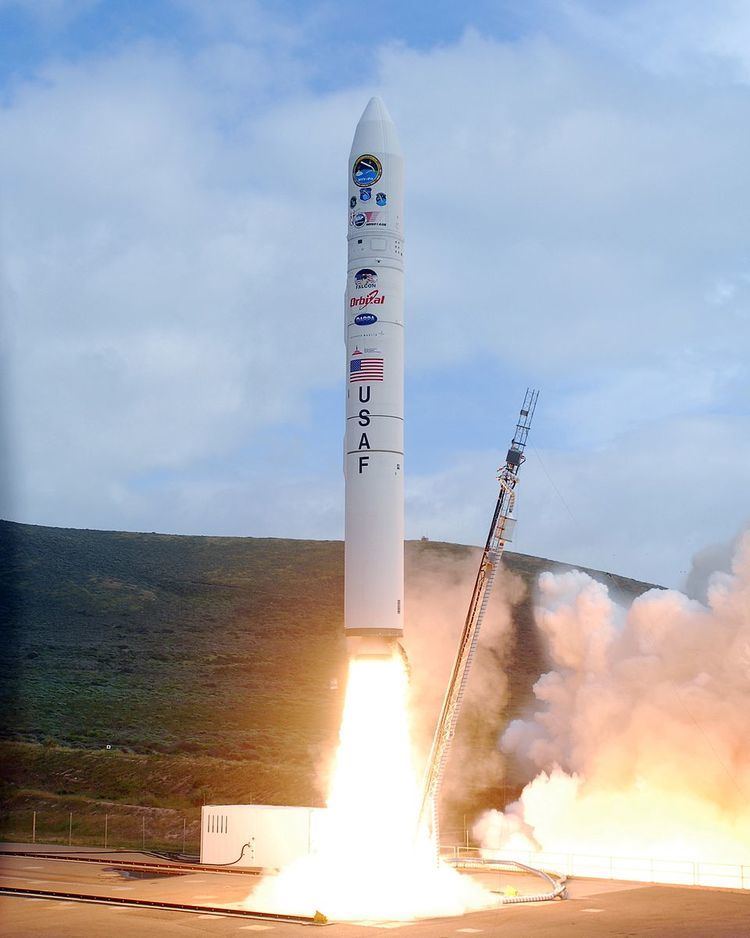Manufacturer Orbital Sciences Height 23.88 meters (78.3 ft) | Cost per launch $50 million Mass 86,300 kg | |
 | ||
Function Expendable launch system Diameter 2.34 meters (7 ft 8 in) | ||
Minotaur IV, also known as Peacekeeper SLV and OSP-2 PK is an active expendable launch system derived from the LGM-118 Peacekeeper ICBM. It is operated by Orbital Sciences Corporation, and made its maiden flight on 22 April 2010, carrying the HTV-2a Hypersonic Test Vehicle. The first orbital launch occurred on 26 September 2010 with the SBSS satellite for the United States Air Force.
The Minotaur IV vehicle consists of four stages and is capable of placing 1,735 kilograms (3,825 lb) of payload into a Low Earth orbit (LEO). It uses the first three stages of the Peacekeeper missile, combined with a new upper stage. On the baseline version, the fourth stage is an Orion 38. However a higher performance variant, designated Minotaur IV+, uses a Star-48V instead. A three-stage configuration (no Orion-38), designated the Minotaur IV Lite, is available for Suborbital trajectories. A five-stage derivative, the Minotaur V, made its maiden flight on 7 Sep 2013.
Minotaur IV launches will be conducted from SLC-8 at Vandenberg Air Force Base, LP-0B at the Mid-Atlantic Regional Spaceport, SLC-46 at Cape Canaveral Air Force Station and Kodiak Launch Complex Pad 1 of the Kodiak Launch Complex.
STP-S26
The third Minotaur IV launch, which was also known as STP-S26, deployed eight payloads. The 26th small launch vehicle mission in STP's 40-year history of flying DoD space experiments, STP-S26 was intended to extend previous standard interface development efforts, implementing a number of capabilities aimed at enabling responsive access to space for small experimental satellites and payloads. STP-S26 launched at 01:45 UTC on 20 November 2010 from the Kodiak Launch Complex. The launch facility contractor was Alaska Aerospace Corporation (AAC). The payloads were released in a 650-kilometer (400 mi) orbit, before the HAPS upper stage was demonstrated by deploying two ballast payloads into a 1,200 km (750 mi) orbit.
The primary objective of the STP-S26 launch was to deploy STPSat-2, whilst demonstrating the ability of the Minotaur IV to carry additional payloads, by deploying FASTSAT, FASTRAC, RAX, O/OREOS and FalconSat-5. A Hydrazine Auxiliary Propulsion System upper stage was flown aboard the Minotaur to demonstrate its ability to deploy payloads to multiple orbits, however only mass simulators were deployed after the HAPS burn.
The launch marked the first flight of a STP-SIV (Standard Interface Vehicle) satellite, the first use of the Multi Mission Satellite Operations Center Ground System Architecture (MMSOC GSA), the first flight of the Minotaur IV's Multi-payload Adapter (MPA), the first use of a HAPS to obtain multiple orbits on a Minotaur IV flight, the first Minotaur launch from Kodiak Launch Complex (KLC), and the first deployment of CubeSats from a Minotaur IV viaPoly-PicoSatellite Orbital Deployers (P-Pods).
